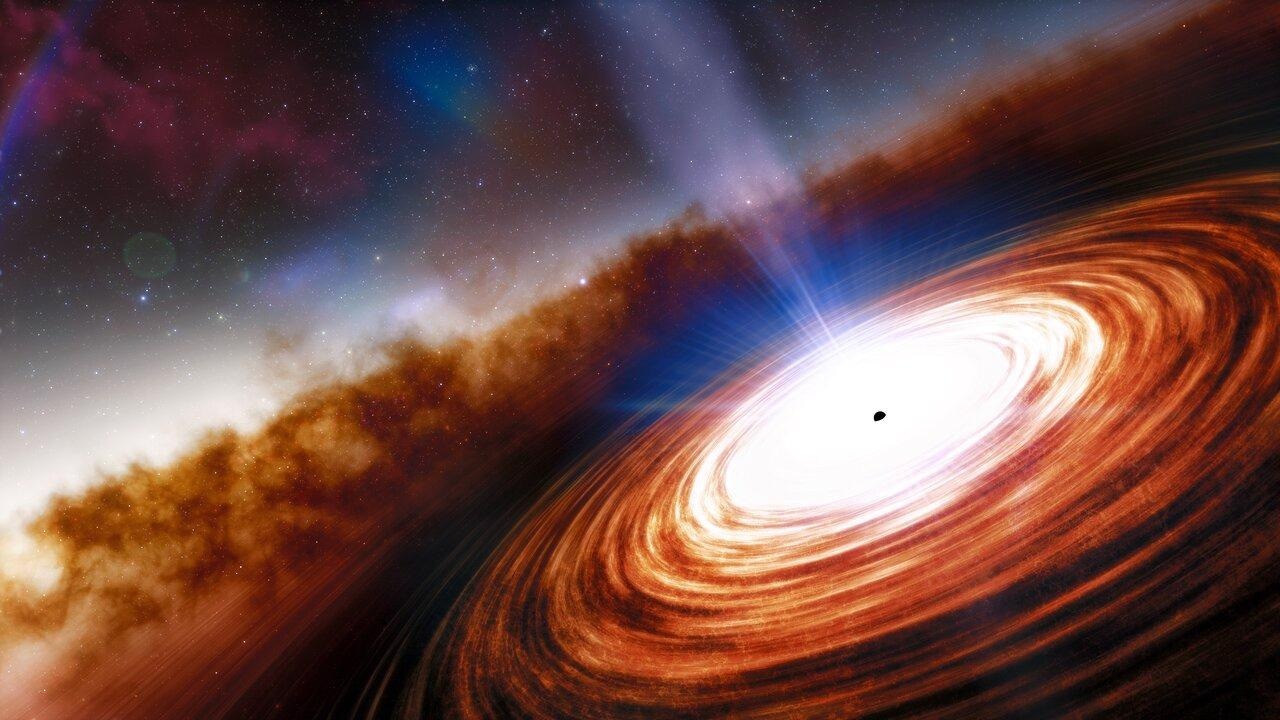Jan 13 2021
Scientists have discovered the most faraway quasar ever known. It is 1000 times more luminous compared to the Milky Way and has been spotted just 670 million years after the Big Bang.
 Artist’s impression of quasar J0313-1806. Image Credit: NOIRLab/NSF/AURA/J. da Silva.
Artist’s impression of quasar J0313-1806. Image Credit: NOIRLab/NSF/AURA/J. da Silva.
The quasar is powered by the earliest known supermassive black hole, with a weight of more than 1.6 billion times that of the Sun. Observed over 13 billion years earlier, this fully grown distant quasar is also the earliest to be discovered, enabling astronomers to understand the formation of massive galaxies in the early Universe. The study findings were recently presented at the January 2021 meeting of the American Astronomical Society.
Quasars are one of the most energetic objects in the Universe and are powered by the feeding frenzies of enormous supermassive black holes. They form when gas in the superheated accretion disk surrounding a supermassive black hole is irrevocably drawn inwards, discharging energy throughout the electromagnetic spectrum.
Quasars emit huge amounts of electromagnetic radiation, where the most enormous examples easily outshine whole galaxies. An international group of astronomers has now reported the discovery of J0313-1806, the most faraway quasar known so far.
The most distant quasars are crucial for understanding how the earliest black holes formed and for understanding cosmic reionization—the last major phase transition of our Universe.
Xiaohui Fan, Study Co-Author and Regents Professor of Astronomy, University of Arizona
J0313-1806 is observed over 13 billion years ago. Being the most faraway quasar to be ever known, it is also the earliest, being completely formed only around 670 million years after the Big Bang. The luminosity of the new quasar is over 10 trillion times that of the Sun—that is, it releases 1000 times more energy compared to the whole Milky Way galaxy.
A supermassive black hole weighing 1.6 billion times as the Sun is the source of this quasar. This black hole is the earliest one currently known to occur in the Universe.
The existence of such an enormous black hole so early in the history of the Universe questions black hole formation theories as astronomers must explain how it occurred when it hardly had the time to do so.
According to Feige Wang, NASA Hubble fellow at the University of Arizona and lead author of the study, “Black holes created by the very first massive stars could not have grown this large in only a few hundred million years.”
The observations that resulted in this finding were achieved using a range of telescopes, which include three National Science Foundation NOIRLab facilities—the Víctor M. Blanco 4-meter Telescope at Cerro Tololo Inter-American Observatory, Gemini North, and Gemini South.
J0313-1806 was first identified using data from the Blanco Telescope, captured as part of the DESI Legacy Imaging Surveys, provided to the astronomical community through the Astro Data Lab at NOIRLab’s Community Science and Data Center (CSDC). Gemini South observations helped confirm its identity as a quasar.
The mass of the central supermassive black hole was measured by using the high-quality spectra from two Maunakea observatories in Hawai‘i—Gemini North and W. M. Keck Observatory.
The most distant quasars and earliest black holes are important markers in the history of the Universe. The researchers combined several of NSF’s NOIRLab facilities to make this discovery.
Martin Still, Program Director, National Science Foundation
Besides weighing the monster black hole, the observations by Gemini North and Keck Observatory unraveled a very fast outflow emitted from the quasar in the form of a high-velocity wind, which travels at 20% the speed of light.
“The energy released by such an extreme high-velocity outflow is large enough to impact the star formation in the entire quasar host galaxy,” noted Jinyi Yang, Peter A. Strittmatter postdoctoral fellow of Steward Observatory at the University of Arizona. This is the earliest known example of a quasar carving its host galaxy’s growth, which makes J0313-1806 a potential target for future observations.
The galaxy that hosts J0313-1806 has been experiencing a surge in star formation, forming new stars 200 times quicker compared to the Milky Way. The blend of such an intense star formation, the high-velocity outflow, and the luminous quasar render J0313-1806 and its host galaxy a potential natural laboratory to gain insights into the growth of supermassive black holes and their host galaxies in the early Universe.
This would be a great target to investigate the formation of the earliest supermassive black holes. We also hope to learn more about the effect of quasar outflows on their host galaxy—as well as to learn how the most massive galaxies formed in the early Universe.
Feige Wang, NASA Hubble Fellow, University of Arizona